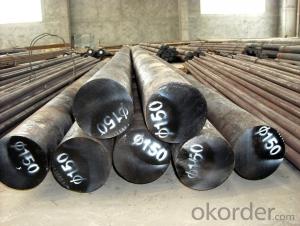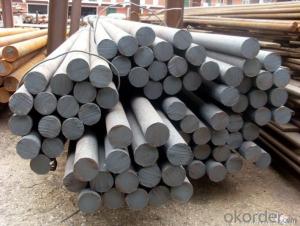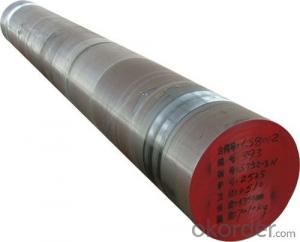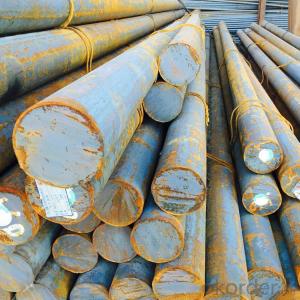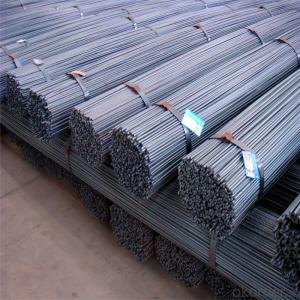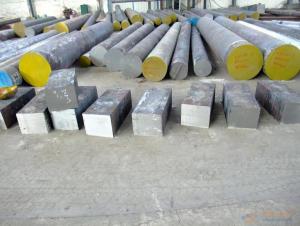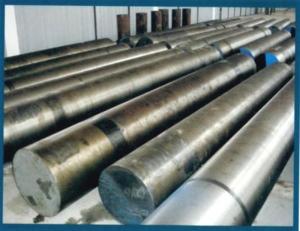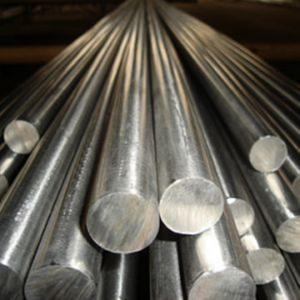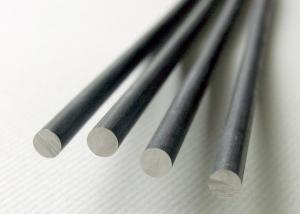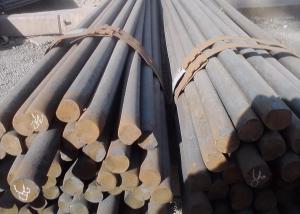Tool Steel SKD10,Cr12Mo1V1, D2,1.2379,2379 Steel Round Bar
- Loading Port:
- China main port
- Payment Terms:
- TT OR LC
- Min Order Qty:
- 25 m.t.
- Supply Capability:
- 10000 m.t./month
OKorder Service Pledge
OKorder Financial Service
You Might Also Like
Item specifice
The details of our Steel
1. Produce Standard: as the GB, AISI, ASTM, SAE, EN, BS, DIN, JIS Industry Standard
2. Produce processes: Smelt Iron -EAF smelt Billet - ESR smelt Billet -Hot rolled or forged get the steel round bar and plate
3. Heat treatment:
Normalized / Annealed / Quenched+Tempered
4. Quality assurance:
All order we can received Third party inspection, You can let SGS, BV,.. and others test company test and inspect our products before Goods shipping.
Product information
1.ChemicalComposition(%) | CSiMnCrMoVPS1.40-1.60≤0.40≤0.60≥11≥0.8≥0.2≤0.030≤0.030
|
2.Equivalent Grades | SKD10/ D2/ 1.2379 |
3.Form&Size | 1)1.2379 Tool Steel round bars, flat/square bars,plates,sheets. |
2)DIN 1.2379 Tool Steel Size Available(Length can be customized)
| |
4.Round bar | Diameter (mm) Length (mm) Round bar: 12~50 x 2000~5800 Hot rolled |
5.Flat bar | Thickness(mm) Width(mm) Length (mm) |
6.Surface Condition | 1)Black,Peeled,Turned,Grinded; 2)D2 die steel should be free of heavy scale,deep pitting,laps,porosity,injurious segregations,excessive nonmetallic inclusions,seams,cracks,slivers,scale marks,dents,soft and hard spots,pipes or any defects that would detrimentally affect the suitability of 1.2379 mold steel. 3)Visual examination for D2 mould steel shall be made to ensure compliance with the requirements for workmanship,finish,dimensions and tolerances,identification marking and packaging. |
7.Straightness | The permissible deviation of 1.2379 tool steel shall not exceed 3mm in 1000mm length.This applies also to bars under 1000mm in length.Measurement is taken on the concave side of D2 steel with a straight edge. |
8.Hardness | AISI 1.2379 tool steel annealed hardness values when obtained in accordance with the latest issue of test methods and definitions A370 shall not exceed 255 Brinell. |
9.HeatTreatment | Annealing |
Hardening | |
Tempering | |
10. Other Tool Steel and Mould Steel grade |
D3/1.2080/X120Cr12, D2/1.2379, SKD11, H13/1.2344, H11/1.2343/4X5MΦC, H21/1.2581, Cr12MoV/ X12MΦ, O1, O2, A2, P20, 1.2714, M2, M3, T1, 4Cr13/40X13, 2Cr13, 9Cr18, DC53, NAK80 etc. |
Product show

Workshop show
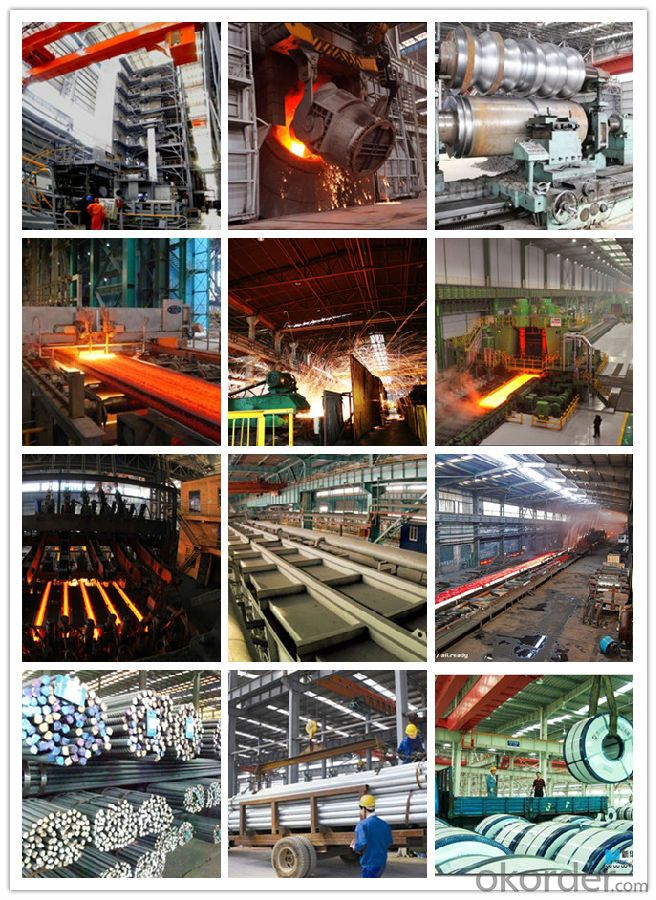
- Q:What are the advantages of using special steel in manufacturing?
- Special steel in manufacturing offers several advantages. Firstly, it provides a higher level of strength and durability compared to regular steel. This is because of the presence of alloying elements, like chromium, nickel, and manganese, which enhance its mechanical properties. As a result, special steel can withstand heavy loads, resist wear and tear, and endure extreme conditions, making it ideal for manufacturing applications requiring strength and longevity. Secondly, special steel exhibits excellent corrosion resistance. The addition of elements like chromium forms a protective oxide layer on the steel's surface, preventing rusting and corrosion when exposed to moisture or harsh environments. This corrosion resistance is crucial in industries such as marine, automotive, and construction, where materials face constant exposure to water, salt, and chemicals. Furthermore, special steel possesses exceptional heat resistance and heat transfer properties. These properties are vital in manufacturing processes involving high temperatures, such as forging, casting, and heat treatment. Special steel retains its strength and structural integrity even at elevated temperatures, enabling the production of components capable of withstanding extreme heat conditions. Another advantage of using special steel in manufacturing is its versatility. It can be easily customized and tailored to specific requirements. Manufacturers can modify it to exhibit various mechanical properties, including hardness, toughness, or flexibility, depending on the application. This flexibility allows for the development of components with precise characteristics, ensuring optimal performance and efficiency. Lastly, special steel proves to be more cost-effective in the long run. Although initial costs may be higher than regular steel, its superior durability and longevity result in reduced maintenance and replacement costs. Additionally, the enhanced properties of special steel can lead to improved energy efficiency and reduced material waste, contributing to overall cost savings in the manufacturing process. In conclusion, the utilization of special steel in manufacturing brings forth benefits such as increased strength and durability, excellent corrosion resistance, superior heat resistance, versatility, and long-term cost-effectiveness. These advantages make it the preferred choice for various industries, guaranteeing the production of high-quality and reliable components.
- Q:Can special steel be used in the renewable energy sector?
- Yes, special steel can be used in the renewable energy sector. Special steel, also known as alloy steel, offers enhanced properties such as high strength, durability, and corrosion resistance, making it suitable for various applications in renewable energy technologies. In wind energy, special steel is utilized for manufacturing wind turbine components. Wind turbine towers require strong and lightweight materials to withstand the dynamic loads and harsh environmental conditions. Special steel alloys, such as high-strength low-alloy (HSLA) steel, provide the necessary strength-to-weight ratio, ensuring the structural integrity of wind turbine towers. Solar energy systems also benefit from special steel. Concentrated solar power (CSP) plants utilize mirrors or lenses to focus sunlight, generating intense heat for electricity generation. Special steel alloys with high thermal conductivity and resistance to high temperatures are used in the construction of these components, ensuring efficient energy capture and durability. Moreover, special steel is employed in the manufacturing of hydroelectric power generation equipment. Turbine components, such as blades, shafts, and runners, require materials with high strength and resistance to erosion and cavitation. Special steel alloys, such as stainless steel and tool steel, possess these characteristics, ensuring the longevity and reliability of hydroelectric power systems. In summary, special steel finds numerous applications in the renewable energy sector. Its properties, including high strength, durability, and corrosion resistance, make it suitable for wind energy, solar energy, and hydroelectric power generation. By using special steel, the renewable energy sector can enhance the performance, efficiency, and lifespan of various renewable energy technologies.
- Q:Can special steel be used in the production of luxury goods?
- Certainly, luxury goods can certainly benefit from the use of special steel in their production. High-quality materials are often necessary to ensure the durability, exclusivity, and overall premium quality of luxury items. Special steels, such as stainless steel, alloy steel, or carbon steel, possess a variety of desirable properties that make them suitable for manufacturing luxury goods. For example, stainless steel is commonly utilized in the creation of luxury watches, jewelry, and accessories because of its resistance to corrosion, shiny appearance, and ability to endure daily wear and tear. Furthermore, certain alloy steels offer exceptional strength and toughness, making them perfect for luxury car components, high-end knives, or designer furniture. Incorporating special steel into luxury goods not only enhances their aesthetic appeal but also contributes to their longevity and value. These materials can be skillfully fashioned into intricate designs, enabling manufacturers to produce unique and exceptional products that cater to the discerning preferences of luxury consumers. All in all, special steel possesses a wide range of qualities that are highly sought after in the production of luxury goods, making it the preferred choice among designers and manufacturers in this industry.
- Q:How does special steel contribute to reducing product lead times?
- Special steel contributes to reducing product lead times by offering several advantages. Firstly, special steel is known for its high strength and durability, allowing manufacturers to produce parts that can withstand harsh conditions and heavy usage. This ensures that the products made with special steel have a longer lifespan, reducing the need for frequent repairs or replacements. Secondly, special steel can be fabricated into complex shapes and sizes, enabling manufacturers to produce intricate components with high precision. This eliminates the need for additional machining processes, saving time and reducing lead times. Lastly, special steel often has improved mechanical properties, such as higher hardness or heat resistance, which can enhance the performance of the final product. This allows manufacturers to meet specific requirements and deliver high-quality products more efficiently, ultimately reducing lead times.
- Q:Can special steel be used in renewable energy applications?
- Yes, special steel can be used in renewable energy applications. Special steel alloys such as stainless steel and high-strength low-alloy (HSLA) steel are commonly used in the manufacturing of wind turbines, solar panels, and hydroelectric power systems. These alloys offer excellent corrosion resistance, high strength, and durability, making them ideal for withstanding harsh environmental conditions and ensuring long-term performance in renewable energy applications.
- Q:What are the different surface finishing methods used for special steel?
- Special steel can be subjected to various surface finishing methods, each serving a distinct purpose and yielding different outcomes. The most commonly employed surface finishing techniques for special steel comprise: 1. Grinding: By utilizing abrasive materials, grinding eliminates excessive material from the steel's surface. This method is primarily employed to attain a polished and sleek finish, while also eradicating any imperfections or roughness. 2. Polishing: By utilizing abrasive materials and polishing compounds, polishing creates a smooth and lustrous surface on the steel. This technique is frequently utilized to enhance the steel's visual appeal and bolster its resistance against corrosion. 3. Shot blasting: Shot blasting involves propelling small metallic or mineral particles onto the steel's surface at high velocities. This process effectively eliminates any impurities, rust, or scale, resulting in a clean and uniform finish. 4. Electroplating: Electroplating involves depositing a thin layer of metal onto the steel's surface via an electrochemical reaction. Commonly employed to improve the steel's appearance, corrosion resistance, and provide a decorative or protective coating. 5. Passivation: Passivation, a chemical process, entails treating the steel's surface with an acid solution to eliminate impurities and create a passive layer that resists corrosion. This method is frequently employed to enhance the corrosion resistance of stainless steel and other alloys. 6. Coating: Coating refers to the application of a protective layer or coating onto the steel's surface. This can involve utilizing paints, lacquers, enamels, or other protective coatings to prevent corrosion, enhance durability, or achieve a specific aesthetic finish. It is crucial to note that the selection of a surface finishing method for special steel heavily depends on the desired outcome, ranging from aesthetics to corrosion resistance or functionality. Furthermore, the specific characteristics of the steel, including its composition, hardness, and intended application, significantly influence the most suitable surface finishing method.
- Q:What are the different methods of preventing pitting corrosion in special steel?
- Various methods exist to prevent pitting corrosion in special steel. The objective of these techniques is to safeguard the steel surface from the harmful effects of its environment and hinder the development of pits. Some commonly used methods include: 1. Passivation: Passivation entails treating the steel surface with a chemical solution or coating to generate a protective oxide layer. This layer functions as a barrier, obstructing the infiltration of corrosive agents and minimizing the risk of pitting corrosion. 2. Alloying: By incorporating specific alloying elements into the steel composition, its resistance to corrosion can be enhanced. Elements like chromium, nickel, and molybdenum are frequently utilized as they augment the steel's capacity to form a stable passive film and withstand pitting corrosion. 3. Cathodic protection: This technique involves either utilizing a sacrificial anode or employing an impressed current on the steel surface. By making the steel cathodic, it becomes less prone to corrosion as electrons are drawn away from it, thus preventing pit formation. 4. Coatings: Applying a protective coating to the steel surface can effectively deter pitting corrosion. Coatings such as paint, epoxy, or polymer-based materials serve as physical barriers, shielding the steel against corrosive agents. 5. Environmental control: Regulating the surrounding environment of the steel can also assist in preventing pitting corrosion. This encompasses measures like controlling temperature, humidity, and pH levels to ensure they remain within acceptable limits, thereby inhibiting the corrosion process. 6. Regular maintenance: Consistent inspection and maintenance of the steel surface are vital in preventing pitting corrosion. Any signs of damage or deterioration should be promptly addressed to prevent further corrosion and potential pitting. It should be noted that the choice of prevention method relies on various factors such as the specific steel composition, the corrosive environment, and the intended application. Proper selection and implementation of these methods can significantly enhance the resilience of special steel to pitting corrosion, guaranteeing its longevity and performance.
- Q:What are the different surface treatments available for special steel?
- There are several surface treatments available for special steel, including galvanizing, powder coating, electroplating, passivation, and nitriding. These treatments enhance the steel's durability, corrosion resistance, appearance, and overall performance in various applications.
- Q:What are the different methods for improving the impact resistance of special steel?
- Special steel can be made more impact resistant through various methods. These methods fall into three main categories: heat treatment, alloying, and surface treatments. Heat treatment is a commonly used method to improve impact resistance. It involves carefully heating and cooling the steel to change its microstructure. Tempering and quenching are the two primary heat treatment processes used for this purpose. Tempering involves heating the steel to a specific temperature and then slowly cooling it. This helps to relieve internal stresses and increase toughness. On the other hand, quenching involves rapidly cooling the steel after heating it to a high temperature. This results in a hardened microstructure, which enhances impact resistance. Alloying is another method to enhance the impact resistance of special steel. By adding specific elements to the base steel, its properties can be improved. For instance, elements like manganese, nickel, or chromium can be added to increase toughness and impact resistance. These alloying elements modify the steel's microstructure, resulting in enhanced strength and resistance to deformation. Surface treatments are used to provide a protective layer on the steel's surface, thereby improving impact resistance. A commonly employed surface treatment is case hardening, which introduces carbon or nitrogen into the outer layer of the steel. This creates a hard surface while maintaining a tough core, resulting in improved impact resistance. Another surface treatment method is shot peening, where the steel surface is bombarded with small particles under high pressure. This induces compressive stresses in the surface layer, enhancing fatigue and impact resistance. In summary, the impact resistance of special steel can be improved through different methods, including heat treatment, alloying, and surface treatments. These methods can be applied individually or in combination to enhance the steel's mechanical properties, making it more resistant to impact and deformation.
- Q:What are the main advantages of using special steel in the automotive industry?
- Special steel has several main advantages in the automotive industry. Firstly, it offers increased strength and durability, allowing for lighter weight components without compromising safety. This not only improves fuel efficiency but also enhances overall vehicle performance. Secondly, special steel has excellent corrosion resistance, ensuring a longer lifespan and reducing maintenance costs. Lastly, its versatility enables the production of complex shapes and designs, enabling manufacturers to create innovative and efficient automotive structures.
1. Manufacturer Overview |
|
|---|---|
| Location | |
| Year Established | |
| Annual Output Value | |
| Main Markets | |
| Company Certifications | |
2. Manufacturer Certificates |
|
|---|---|
| a) Certification Name | |
| Range | |
| Reference | |
| Validity Period | |
3. Manufacturer Capability |
|
|---|---|
| a)Trade Capacity | |
| Nearest Port | |
| Export Percentage | |
| No.of Employees in Trade Department | |
| Language Spoken: | |
| b)Factory Information | |
| Factory Size: | |
| No. of Production Lines | |
| Contract Manufacturing | |
| Product Price Range | |
Send your message to us
Tool Steel SKD10,Cr12Mo1V1, D2,1.2379,2379 Steel Round Bar
- Loading Port:
- China main port
- Payment Terms:
- TT OR LC
- Min Order Qty:
- 25 m.t.
- Supply Capability:
- 10000 m.t./month
OKorder Service Pledge
OKorder Financial Service
Similar products
New products
Hot products
Hot Searches
Related keywords

